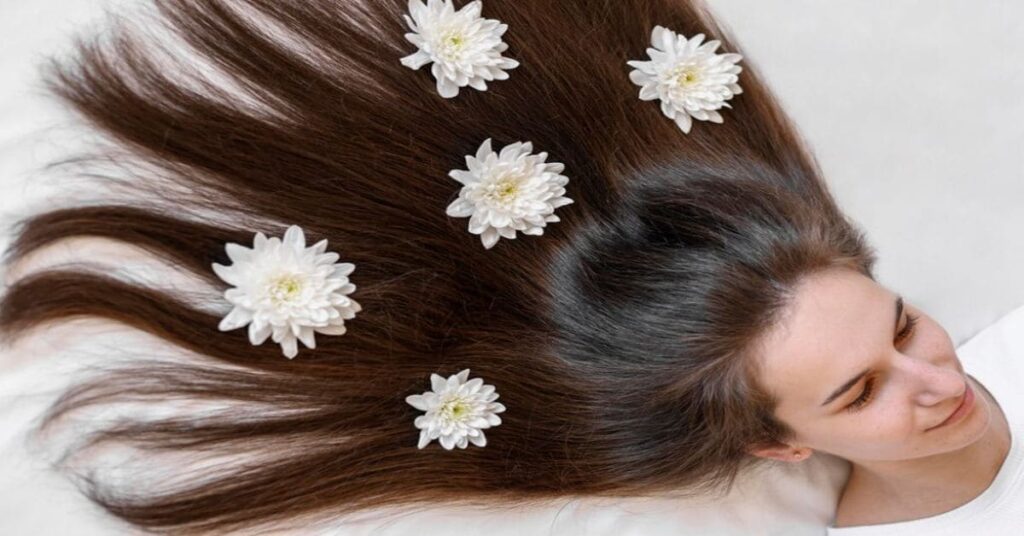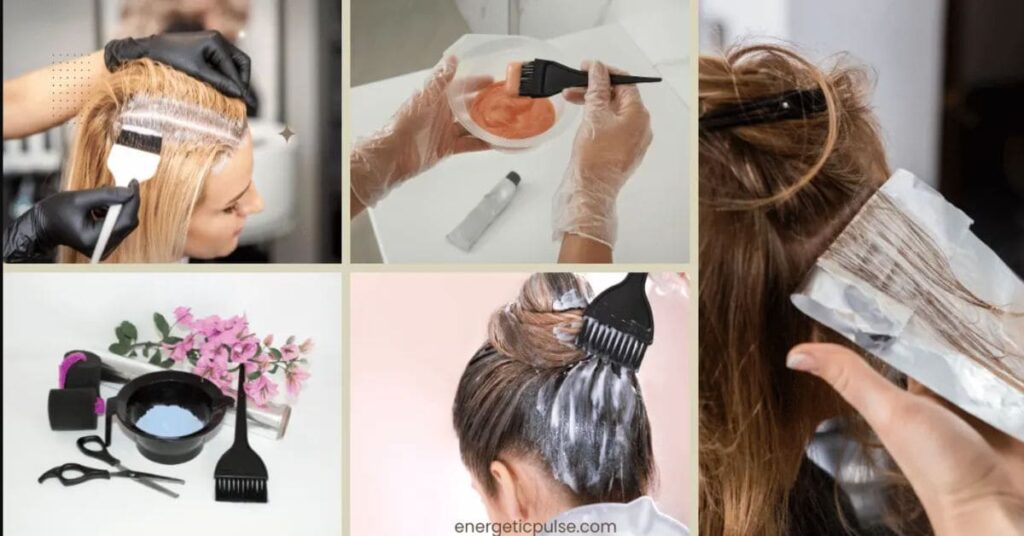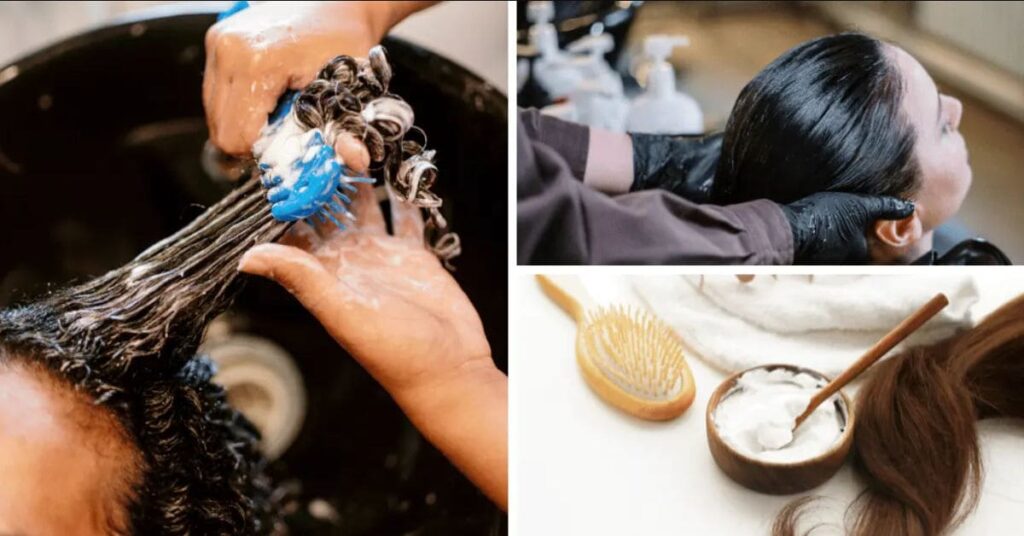Growing hair faster can be influenced by various factors, including genetics, overall health, and hair care practices. While there’s no miracle solution to make your hair grow significantly faster overnight, there are several tips that can help promote healthy hair growth. Here are five tips:
1. Maintain a Balanced Diet

Maintaining a balanced diet is crucial for promoting overall health, including the health of your hair. Here’s a more detailed explanation of how various nutrients found in a balanced diet can support hair growth:
Protein: Hair is primarily made up of protein, so it’s essential to ensure an adequate intake of this nutrient. Foods rich in protein, such as lean meats, fish, poultry, eggs, dairy products, legumes, nuts, and seeds, provide the building blocks necessary for hair growth and repair.
Vitamins: Several vitamins play key roles in promoting healthy hair growth.
Vitamin A helps produce sebum, which moisturizes the scalp and keeps hair healthy. Sources include sweet potatoes, carrots, spinach, and kale.
Vitamin C: A powerful antioxidant that aids in collagen production, which is essential for hair structure. Citrus fruits, strawberries, bell peppers, and broccoli are excellent sources.
Vitamin D: helps stimulate hair follicles, promoting new hair growth. Fatty fish, fortified dairy products, and sunlight exposure are primary sources.
Vitamin E: enhances blood circulation to the scalp, promoting hair growth. Nuts, seeds, spinach, and avocados are good sources.
Biotin (Vitamin B7): Supports the production of keratin, a protein that makes up hair. Eggs, nuts, whole grains, and leafy greens are rich in biotin.
Minerals: Certain minerals are essential for healthy hair growth:
Iron: helps transport oxygen to hair follicles, promoting growth. Red meat, poultry, fish, lentils, and spinach are good sources.
Zinc: supports hair growth and repair by maintaining the health of hair follicles. Oysters, beef, pumpkin seeds, and lentils are rich in zinc.
Omega-3 Fatty Acids: These healthy fats contribute to scalp health and can help reduce inflammation, which may promote hair growth. Fatty fish like salmon, walnuts, flaxseeds, and chia seeds are excellent sources of omega-3 fatty acids.
Hydration: Drinking an adequate amount of water is essential for overall health, including the health of your hair. Proper hydration helps maintain scalp health and promotes the transport of nutrients to the hair follicles.
2. Scalp Care

Scalp care is essential for maintaining healthy hair growth and overall hair health. Here’s a more detailed explanation of why scalp care is important and how to take care of your scalp effectively:
Scalp Health: The scalp is the foundation for healthy hair. It contains hair follicles, sebaceous glands, and blood vessels that deliver nutrients to the hair roots. A healthy scalp provides an optimal environment for hair growth by keeping hair follicles clean and unclogged.
Cleaning: Regular cleansing of the scalp is crucial for removing dirt, excess oil (sebum), sweat, and product buildup. When the scalp is not properly cleansed, these substances can accumulate, leading to clogged pores, inflammation, and potential hair loss. Choose a gentle shampoo suitable for your hair type and scalp condition, and massage it into your scalp using your fingertips to effectively cleanse and stimulate circulation.
Conditioning: While conditioning primarily focuses on the hair shaft, it’s also important to ensure that the scalp receives adequate hydration and nourishment. Applying conditioner to the lengths of your hair while avoiding the scalp can help prevent excess buildup and oiliness. However, if you have a dry scalp, consider using a lightweight conditioner or a scalp treatment specifically formulated to hydrate and soothe the scalp.
Scalp Massage: Massaging the scalp regularly can help improve circulation, which promotes hair growth and scalp health. Use your fingertips to gently massage your scalp in circular motions, starting from the front and working your way to the back. This not only stimulates blood flow but also helps distribute natural oils evenly, keeping the scalp moisturized and nourished.
Avoiding Irritants: Certain hair care products, styling techniques, and environmental factors can irritate the scalp and contribute to issues like dandruff, itchiness, and inflammation. Avoid overusing heat-styling tools, harsh chemicals, and tight hairstyles that pull on the scalp. Additionally, protect your scalp from sun exposure by wearing a hat or applying sunscreen when spending extended periods outdoors.
Balanced Diet and Hydration: As mentioned earlier, maintaining a balanced diet and staying hydrated are essential for scalp health. Nutrient-rich foods and adequate hydration support overall skin health, including the scalp, and help maintain its natural balance.
Seek Professional Help: If you experience persistent scalp issues such as dandruff, itching, or hair loss, consider consulting a dermatologist or a trichologist for proper diagnosis and treatment. They can recommend specialized scalp treatments or medicated shampoos to address specific concerns and promote scalp health.
By incorporating these scalp care practices into your hair care routine, you can help maintain a healthy scalp environment conducive to optimal hair growth and overall hair health.
3. Minimize heat styling and Chemical Treatments
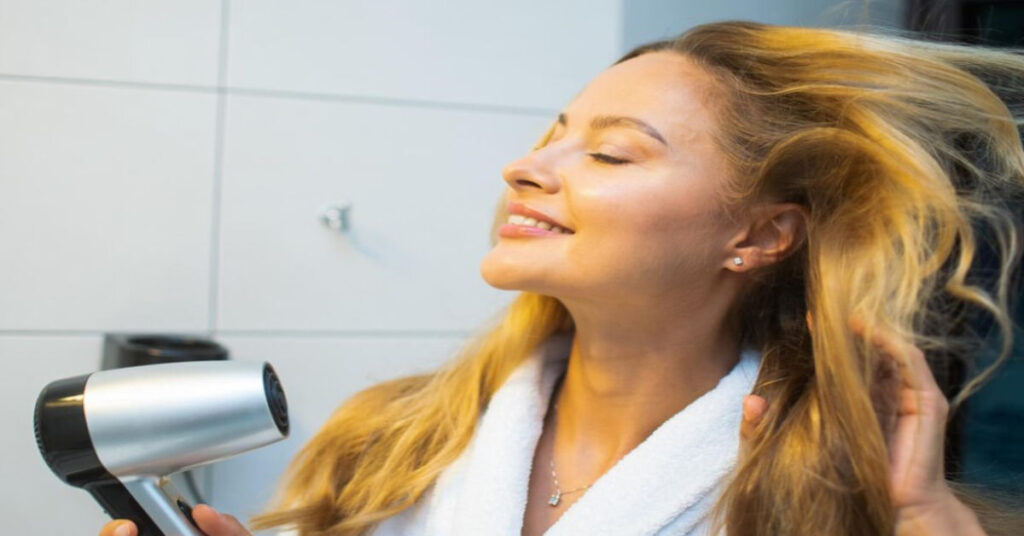
Minimizing heat styling and chemical treatments is crucial for maintaining the health and integrity of your hair. Here’s a more detailed explanation of why these practices can be damaging and how to reduce their negative impact:
Heat Styling: Excessive use of heat-styling tools such as flat irons, curling irons, and blow dryers can cause damage to the hair cuticle, leading to dryness, breakage, and split ends. The high temperatures from these tools strip the hair of its natural moisture, making it more prone to damage. To minimize the damage from heat styling:
- Use heat protectant sprays or serums before using heat styling tools to create a protective barrier between the hair and the heat.
- Limit the frequency of heat styling and opt for air-drying whenever possible.
- Use the lowest heat setting necessary to achieve your desired hairstyle, and avoid prolonged exposure to heat.
Chemical Treatments: Chemical treatments such as perms, relaxers, bleaching, and coloring can weaken the hair shaft and alter its structure, making it more susceptible to breakage and damage. The harsh chemicals used in these treatments can disrupt the natural balance of the hair and scalp, leading to dryness, irritation, and hair loss. To minimize the damage from chemical treatments:
Choose ammonia-free or gentle formulations when coloring or bleaching your hair.
- – Follow the instructions provided by professionals carefully, and do not leave chemical treatments on your hair for longer than recommended.
- – Give your hair time to recover between chemical treatments by spacing them out and using nourishing hair masks or treatments to restore moisture and strength.
- – Consider alternative methods such as henna or semi-permanent dyes, which are gentler on the hair and scalp.
Protective Styling: Embrace protective hairstyles that minimize the need for heat styling and reduce manipulation of the hair. Styles such as braids, twists, buns, and updos can help protect your hair from environmental damage and reduce the risk of breakage.
Healthy Hair Care Practices: Adopt healthy hair care practices that focus on nourishing and strengthening the hair from within. This includes using moisturizing shampoos and conditioners, incorporating regular deep conditioning treatments, and maintaining a balanced diet rich in vitamins, minerals, and protein.
Regular Trimming: Regular trims help remove split ends and prevent further damage, promoting healthy hair growth. Aim to trim your hair every 6-8 weeks to maintain its health and prevent split ends from traveling up the hair shaft.
By minimizing heat styling and chemical treatments and adopting healthy hair care practices, you can help protect your hair from damage and maintain its strength, shine, and vitality.
4. Trim Regularly
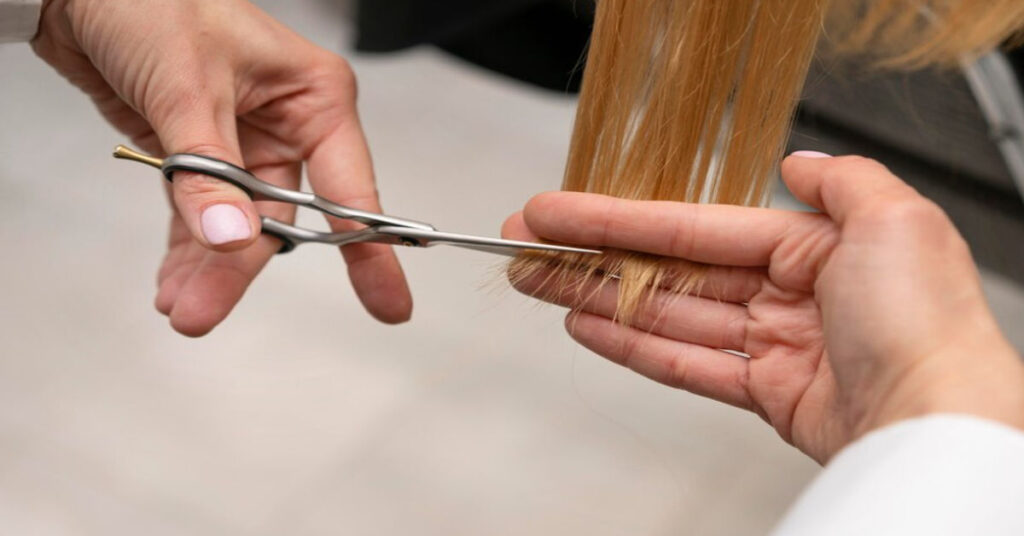
Certainly! Regular trimming is a crucial aspect of maintaining healthy hair, and it plays a significant role in promoting hair growth. Here’s a more detailed explanation of why trimming regularly is important and how it contributes to healthy hair:
Prevention of Split Ends: Split ends occur when the protective outer layer of the hair cuticle is damaged or begins to fray, causing the hair to split into two or more strands. If left unaddressed, split ends can travel up the hair shaft, leading to further damage and breakage. Regular trims help prevent split ends by removing the damaged portions of the hair, keeping the ends healthy and intact.
Reduction of Breakage: Hair that is prone to split ends is also more susceptible to breakage. By trimming regularly, you eliminate weak and damaged areas of the hair, reducing the likelihood of breakage and allowing your hair to grow longer and stronger.
Promotion of Hair Growth: While trimming hair doesn’t directly affect the rate of hair growth from the scalp, it does contribute to the overall appearance and health of your hair. By removing split ends and preventing breakage, regular trims can make your hair look fuller, thicker, and healthier. This can give the impression that your hair is growing faster, as it appears more robust and less prone to breakage.
Maintenance of Style: Regular trims are essential for maintaining the shape and style of your hair, especially if you have layers, bangs, or a specific haircut. Trimming every 6-8 weeks helps keep your hair looking neat and well-groomed, preserving the integrity of your hairstyle and ensuring that it grows out evenly.
Prevention of Tangling and Knots: Split ends and damaged hair are more prone to tangling and forming knots, which can be frustrating to deal with and may result in further breakage when combing or brushing. By keeping your ends trimmed and healthy, you can minimize tangling and knots, making it easier to manage your hair and reducing the risk of damage during styling.
Overall, regular trims are essential for maintaining the health, strength, and appearance of your hair. While the frequency of trims may vary depending on your hair type, texture, and styling habits, scheduling a trim every 6-8 weeks is a good rule of thumb to keep your hair looking its best and promote healthy growth.
5. Use Hair Growth Supplements or Treatments

Hair growth supplements and treatments are often marketed as solutions to promote faster hair growth and improve overall hair health. Here’s a more detailed explanation of these options and how they can potentially support hair growth:
Hair Growth Supplements: These are oral supplements formulated with vitamins, minerals, amino acids, and other nutrients believed to support hair health and stimulate growth. Common ingredients found in hair growth supplements include biotin, vitamins A, C, D, and E, iron, zinc, and collagen.
- Biotin, also known as vitamin B7, is a popular ingredient in hair growth supplements. It plays a crucial role in the production of keratin, a protein that forms the structure of hair strands.
- Vitamins and Minerals: Nutrients like vitamins A, C, D, and E, as well as iron and zinc, are essential for maintaining healthy hair follicles and promoting proper hair growth. Deficiencies in these nutrients can lead to hair loss or slow growth.
- Collagen: Collagen is a protein that provides structure and strength to hair, skin, and nails. Some supplements contain collagen peptides, which are believed to support hair growth and improve hair texture and thickness.
It’s important to note that while hair growth supplements may provide nutritional support for hair health, results can vary, and they may not work for everyone. It’s essential to consult with a healthcare professional before starting any new supplement regimen, especially if you have underlying health conditions or are taking medications that could interact with the supplements.
Topical Treatments: Topical treatments are applied directly to the scalp and hair and typically contain ingredients that stimulate circulation, nourish the scalp, and promote hair growth. Common ingredients found in topical treatments include minoxidil, caffeine, essential oils, and botanical extracts.
- Minoxidil is an FDA-approved topical medication for promoting hair growth in both men and women with hereditary hair loss. It works by increasing blood flow to the scalp and prolonging the growth phase of the hair follicles.
- Caffeine is believed to stimulate hair follicles and promote hair growth. Some topical treatments contain caffeine as a key ingredient to help improve hair density and thickness.
- Essential oils like rosemary, peppermint, and lavender, as well as botanical extracts such as saw palmetto and pumpkin seed oil, are often used in topical treatments for their potential to nourish the scalp, reduce inflammation, and promote hair growth.
Topical treatments can be used alone or in conjunction with oral supplements to enhance their effectiveness. It’s important to follow the manufacturer’s instructions carefully and be consistent with the application to achieve optimal results.
While hair growth supplements and treatments can be beneficial for some individuals, they are not guaranteed to produce dramatic results, and individual responses may vary. Additionally, addressing underlying factors such as nutrition, scalp health, and lifestyle habits is essential for supporting overall hair growth and health. Consulting with a healthcare professional or dermatologist can help determine the best approach for your specific needs and concerns.
